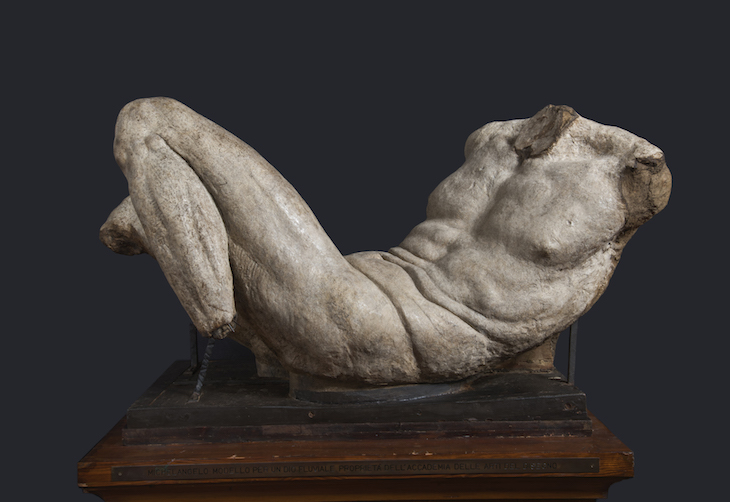The torso of Michelangelo’s River God (c. 1526– 27), once bright white but long since mellowed to the silvery grey of driftwood, is an almost talismanic presence at the beginning of this exhibition, the third and final part of the Palazzo Strozzi’s reassessment of Mannerism. Made not from marble, but from clay mixed with plant and vegetable fibres, earth and sand, this preliminary model lies capsized somewhat, its position dictated by its precarious physical condition, all in disconcerting contrast to the exalted name of its maker.
If the twist of the river god’s torso is a trope so familiar as to need no introduction, the same can hardly be said for Andrea’s painting. And yet we know from the vast numbers of copies of Andrea del Sarto’s works that in his own time he was revered, described by the writer Francesco Bocchi as ‘marvellous to such a point that other painters could only envy him rather than attempt to surpass him’, his name uttered in the same breath as Leonardo, Raphael and Michelangelo. It is testament to the profound and distorting influence of the painter and proto-art historian Vasari that his immortalisation of Michelangelo, the only living artist to be included in the first edition of the Lives, left so many others chronically underappreciated.
While Michelangelo’s expression of powerful, dynamic form is a recurring motif, the tender naturalism of Andrea del Sarto’s Lamentation represents an alternative artistic heritage, in a version of the cinquecento characterised by the range and versatility of its artists. Andrea’s emotionally accessible, easily readable compositions and frank references to the Eucharist provided a model for artists adapting to Church reforms that began with the Lutheran rumblings of 1517.
Despite Pontormo’s Deposition (1525–28) being described by Vasari as ‘without shadows, and with a colouring so bright and so uniform, that one can scarcely distinguish the lights from the middle tints, and the middle tints from the darks’, there is the suspicion that it has been tuned to an excessive level of flatness and polish during its recent cleaning. Even so, its extraordinary use of colour imbues the painting’s naturalistic elements with a disconcerting otherworldliness. The figures occupy a void, and yet any sense of weightlessness is countered by the sheer bulk of Christ’s body, a contrast that draws attention to the Eucharistic significance of the picture with a finesse reminiscent of Andrea.
As the Catholic church defended the doctrine of transubstantiation against Protestant criticisms, the body of Christ was given renewed emphasis, a strategy that resulted in inevitable but fascinating tensions. This is nowhere more pronounced than in Giambologna’s lifesize Crucifix of around 1598, in which Christ’s holiness is expressed through his physical perfection, his body the site of sensual, as well as pious, adoration.
The idea of the body as an index of virtue achieves dramatic effect in Giovanni Stradano’s Crucifixion (1569), in which the contortions of the bad thief contrast with the serenity of Christ himself, the painting’s macabre and naturalistic details pointing to the artist’s Flemish origins. In a room dedicated to Counter-Reformation altarpieces, an array of stylistic influences, including from northern Europe, Michelangelo, and Andrea del Sarto, contribute to the formulation of new imagery, at once didactic and emotionally charged.
No one was more adept at negotiating these new standards than Santi di Tito, heir to Andrea’s legacy via his teacher Bronzino, himself a pupil of Pontormo. In his Resurrection (c. 1574), he synthesises the heroic with the naturalistic, to create an altarpiece in keeping with Counter-Reformation demands. Best known for his religious paintings, Santi di Tito is revealed here as an artist of remarkable range, the multiple registers on which his altarpieces function echoed in the scope of his wider output.
Like his contemporaries Giambologna and Alessandro Allori, Santi di Tito worked with a variety and inventiveness that refutes the notion of the cinquecento as a period of stagnation and decay. Examples of his portraits and allegorical paintings, in galleries that evoke domestic interiors, and Francesco de’ Medici’s Studiolo in the Palazzo Vecchio, contribute to the sense of a time rich in ideas and experiences, with artists adapting the achievements of the recent past to negotiate the challenges of their own time. In his jewellike oil on copper, Jacopo Zucchi catalogues natural objects and creatures with a scientific precision that belies his religious subject. Valerio Cioli’s Portrait of the Dwarf Barbino (1564–66), signals a new embrace of naturalism, while Vincenzo de’ Rossi’s Dying Adonis (1565–70), reverts once again to Michelangelo’s heroic nudes. Restrained female portraits, like the marble bust of Cassandra del Ghirlandaio Sirigatti (1578), by Ridolfo Sirigatti, suggest women accorded status in their own right.
While the final rooms show the generation of artists after Bronzino pursuing a naturalism that anticipates Caravaggio, they nevertheless reintroduce the sense of fin de siècle that the exhibition tries so hard to shake off. Plunged into ecclesiastical gloom, the fainting woman in Alessandro Allori’s The Miracles of St Fiacre (c. 1596), typifies the highly-strung religiosity of these turn of the century altarpieces. If the exhibition attempts to move away from the idea of Mannerism as the autumn of the Renaissance, it succeeds, if only to recast it as something of an Indian summer.
‘The Cinquecento in Florence: From Michelangelo and Pontormo to Giambologna’ is at the Palazzo Strozzi, Florence, until 21 January 2018.
From the November 2017 issue of Apollo: preview and subscribe here
